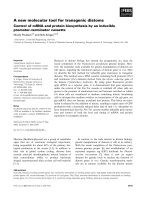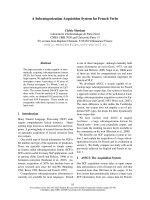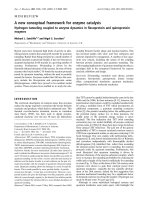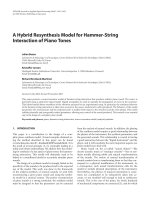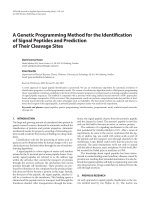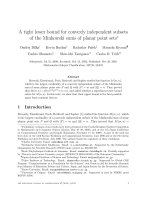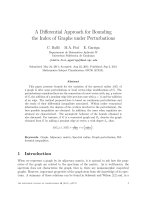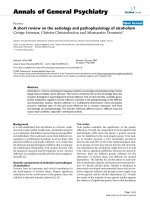Báo cáo y học: " A remission spectroscopy system for in vivo monitoring of hemoglobin oxygen saturation in murine hepatic sinusoids, in early systemic inflammation" doc
Bạn đang xem bản rút gọn của tài liệu. Xem và tải ngay bản đầy đủ của tài liệu tại đây (304.6 KB, 8 trang )
BioMed Central
Page 1 of 8
(page number not for citation purposes)
Comparative Hepatology
Open Access
Research
A remission spectroscopy system for in vivo monitoring of
hemoglobin oxygen saturation in murine hepatic sinusoids, in early
systemic inflammation
Christian Wunder*
1
, Robert W Brock
3
, Alfons Krug
2
, Norbert Roewer
1
and
Otto Eichelbrönner
1
Address:
1
Klinik und Poliklinik für Anästhesiologie, Julius-Maximilians-Universität Würzburg, Zentrum für Operative Medizin, Oberdürrbacher
Strasse 6, 97080 Würzburg, Germany,
2
LEA Medizintechnik GmbH, 35394 Giessen, Germany and
3
Department of Pharmacology & Toxicology,
University of Arkansas for Medical Sciences, 72205-7199 Little Rock, USA
Email: Christian Wunder* - ; Robert W Brock - ; Alfons Krug - ;
Norbert Roewer - ; Otto Eichelbrönner -
* Corresponding author
Abstract
Background: During the early stages of systemic inflammation, the liver integrity is compromised
by microcirculatory disturbances and subsequent hepatocellular injury. Little is known about the
relationship between the hemoglobin oxygen saturation (HbsO
2
) in sinusoids and the
hepatocellular mitochondrial redox state, in early systemic inflammation. In a murine model of early
systemic inflammation, we have explored the association between the sinusoidal HbsO
2
detected
with a remission spectroscopy system and 1.) the NAD(P)H autofluorescence (an indicator of the
intracellular mitochondrial redox state) and 2.) the markers of hepatocellular injury.
Results: Animals submitted to 1 hour bilateral hindlimb ischemia (I) and 3 hours of reperfusion (R)
(3.0 h I/R) exhibited lower HbsO
2
values when compared with sham. Six hours I/R (1 hour bilateral
hindlimb ischemia and 6 hours of reperfusion) and the continuous infusion of endothelin-1 (ET-1)
further aggravated the hypoxia in HbsO
2
. The detected NAD(P)H autofluorescence correlated
with the detected HbsO
2
values and showed the same developing. Three hours I/R resulted in
elevated NAD(P)H autofluorescence compared with sham animals. Animals after 6.0 h I/R and
continuous infusion of ET-1 revealed higher NAD(P)H autofluorescence compared with 3.0 h I/R
animals. Overall the analysed HbsO
2
values correlated with all markers of hepatocellular injury.
Conclusion: During the early stages of systemic inflammation, there is a significant decrease in
hepatic sinusoidal HbsO
2
. In parallel, we detected an increasing NAD(P)H autofluorescence
representing an intracellular inadequate oxygen supply. Both changes are accompanied by
increasing markers of liver cell injury. Therefore, remission spectroscopy in combination with
NAD(P)H autofluorescence provides information on the oxygen distribution, the metabolic state
and the mitochondrial redox potential, within the mouse liver.
Published: 12 January 2005
Comparative Hepatology 2005, 4:1 doi:10.1186/1476-5926-4-1
Received: 20 October 2004
Accepted: 12 January 2005
This article is available from: />© 2005 Wunder et al; licensee BioMed Central Ltd.
This is an Open Access article distributed under the terms of the Creative Commons Attribution License ( />),
which permits unrestricted use, distribution, and reproduction in any medium, provided the original work is properly cited.
Comparative Hepatology 2005, 4:1 />Page 2 of 8
(page number not for citation purposes)
Background
Hepatic microcirculatory failure is a major prerequisite for
the development of hepatocellular dysfunction in a
number of conditions like trauma/hemorrhage, liver
transplantation and systemic inflammation. In various
inflammatory states, the degree of lethal hepatocyte
necrosis can be predicted from the extent of hepatic
microcirculatory failure [1], possibly via alterations in the
mitochondrial redox state of the liver [2,3]. Previously,
our group has shown that the development of systemic
inflammation was associated with a disturbance of the
hepatic microcirculation, and a subsequent increase in
hepatocellular damage [4,5]. The causal mechanisms are
not completely understood, but accumulating evidence
suggests a dysregulation of stress-inducible vasoactive
mediators like endothelins, nitric oxide synthase or heme
oxygenase [6]. Moreover, modifications in effector cell
function may also alter the response to those mediators
[7]. Hepatic microcirculatory failures during various
stresses are typically characterized by alterations in the
distribution of perfusion, thereby resulting in a disparity
between oxygen supply and demand. This impaired nutri-
tive blood flow, together with reduced oxygen availability,
decreases cellular high-energy phosphates leading to an
early hepatocellular injury and dysfunction. Studies of tis-
sue oxygenation focusing on the relationship between
microcirculatory disturbances and oxygen transport
dynamics may help to better elucidate the pathophysio-
logical mechanisms involved.
Several methods have been reported in the past couple of
years directly quantifying the oxygen distribution in tis-
sues; however, their applicability in tissues, especially in
small rodents like mice, is limited due to technical rea-
sons. For instance, microelectrodes measure tissue pO
2
at
specific points; but the technique is invasive and con-
sumes oxygen. Electron paramagnetic resonance oximetry
techniques or nuclear MRI approaches allow the detection
of changes in tissue pO
2
; however, their resolution is too
low [8]. A fluorescent membrane, developed by Itoh et al.
[9] on the basis of an oxygen-quenched fluorescent dye
allows the in vivo visualization of the tissue pO
2
. This tech-
nique allows the visualization of oxygen distribution on
tissue surfaces, but this method comprised some technical
limitations. The oxygen-sensitive membrane has to be
used under gastight and watertight conditions during
microscopy and the fluorescent membrane shows a pho-
tobleaching effect. Paxian et al. [10] recently demon-
strated that the intravenous infusion of a special oxygen
quenching dye allowed the visualization of the oxygen
distribution on the liver surface using intravital videomi-
croscopy. The fluorescence of the dye was directly depend-
ent on the tissue pO
2
. A disadvantage of this method,
especially when used in small rodents like mice, is that it
requires changing the continuous intravenous infusion
rates of the dye to provide stable plasma concentrations.
With mice (increasingly used as laboratory animals) there
is a growing need for a method able to reliably detect tis-
sue oxygenation or, at least, hemoglobin oxygen satura-
tion (HbsO
2
) in capillaries of small animals.
The aim of the present study was to investigate whether
the utility of a new and simple remission spectroscopy
system allows reliable in vivo detection of liver sinusoidal
HbsO
2
. In a mouse model of early systemic inflamma-
tion, we examined whether the detected changes in
hepatic HbsO
2
correlated with the established method of
NAD(P)H autofluorescence and hepatocellular injury.
Results
Macrohemodynamics
Consistent with previous reports [4,11], mean arterial
pressure (MAP) was significantly lower in animals after
ischemia (I) and reperfusion (R) (3.0 h I/R and 6.0 h I/R)
compared to sham animals, but remained normotensive
(> 80 mmHg) throughout the study. MAP did not differ
between the I/R groups. Central venous pressure was not
different (data not shown).
Blood gas analysis
The measurement of arterial blood gases carried out after
the microscopy procedure showed normal oxygenation, a
moderate acidosis, and adequate pCO
2
for all groups
Table 1: Arterial blood gases.
pO
2
(mmHg) pH pCO
2
(mmHg)
Sham 128 (46) 7.29 (0.13) 35.8 (11.3)
3.0 h I/R 123 (49) 7.27 (0.15) 36.7 (10.8)
6.0 h I/R 116 (38) 7.26 (0.17) 36.8 (12.4)
6.0 h I/R+endothelin-1 119 (46) 7.26 (0.13) 36.9 (12.9)
Data expressed as Mean (SD); n = 7 for each group
Comparative Hepatology 2005, 4:1 />Page 3 of 8
(page number not for citation purposes)
(Table 1).
Hepatic sinusoidal hemoglobin oxygen saturation (HbsO
2
)
Hepatic sinusoidal HbsO
2
of the different groups are
shown in Figure 1. Animals treated with 3.0 h I/R have sig-
nificant lower hepatic HbsO
2
values (56.2 (13.1)) when
compared with sham (68.4 (14.1); p < 0.01). No statisti-
cally significant differences were observed between 3.0 h
I/R and 6.0 h I/R treated animals. However, an obvious
shift of hepatic HbsO
2
towards a lower oxygenation was
observed when compared with 3.0 h I/R treated animals.
Animals treated with 6.0 h I/R and a continuous infusion
of endothelin-1 (ET-1) showed significant reduced HbsO
2
values (44.8 (14.7)) when compared with 3.0 h I/R
treated animals (56.2 (13.2); p < 0.006). More than half
of the measured data from these animals revealed HbsO
2
values lower than 50%. There was no apparent difference
in the local tissue hemoglobin (Hb) content detected
(data not shown).
Hepatic tissue redox status
Animals subjected to 3.0 h I/R revealed significantly
higher NAD(P)H autofluorescence (141.6 (12.8)); there-
fore, a significant decline in hepatic tissue oxygenation
was observed when compared with sham (100.0 (6.7))
(Figure 2). Three hours I/R treated animals failed to show
a significant difference in NAD(P)H autofluorescence
when compared with the 6.0 h I/R treated animals. Ani-
mals treated with 6.0 h I/R and a continuous infusion of
ET-1 demonstrated significantly higher NAD(P)H
autofluorescence (161.1 (13.8)) when compared to the
3.0 h I/R treated animals (141.6 (12.8)). There was a
highly significant correlation found between NAD(P)H
autofluorescence and hepatic HbsO
2
detected in the same
animal (p < 0.005; r
2
= 0.94), as depicted in Figure 3.
Hepatic tissue injury
Serum alanine aminotransferase (ALT) and serum aspar-
tate aminotransferase (AST) levels are summarized in
Table 2. When compared with sham animals, mice treated
with 3.0 h I/R exhibited significantly higher levels of ALT
and AST. No significant changes between 3.0 h I/R and 6.0
h I/R animals were detectable. When compared with 3.0 h
I/R, mice treated with 6.0 h I/R and a continuous infusion
of ET-1 showed significant higher ALT and AST levels. The
results of labelling lethally injured hepatocytes with pro-
pidium iodide (PI) are shown in Figure 4. The 3.0 h I/R
treated animals exhibited a significantly increase in
lethally injured hepatocytes (120.4 (44.0)) compared
with sham (25.7 (17.9)), whereas the 6.0 h I/R group had
a significant higher number of dead hepatocytes (260.1
(52.7)) than the 3.0 h I/R treated animals. The treatment
of 6.0 h I/R animals with a continuous ET-1 infusion fur-
ther elevated the degree of lethally injured hepatocytes
(361.8 (56.0)) when compared to the 6.0 h I/R treated
animals. Regression analysis between lethally injured
hepatocytes and hepatic HbsO
2
revealed a significant cor-
relation (p < 0.001; r
2
= 0.86), as shown in Figure 5.
Discussion
In the present study, we demonstrate the utility of a remis-
sion spectroscopy system for the in vivo measurement of
murine hepatic sinusoidal HbsO
2
that showed a signifi-
cant correlation with the established method of NAD(P)H
autofluorescence, as well as with the extent of hepatic tis-
sue injury.
Oximetry relies on the detection of the spectral properties
of oxygenated and reduced Hb. In vitro bench analysis
capabilities have spurred the desire to accomplish accu-
rate in vivo measurement through various techniques. The
1930's and 1940's were a particularly active period for oxi-
metry advances culminating in the development of pulse
oximeters in the 1970's [12]. Remission spectroscopy is
based on the same principles of those oximeters, namely
because they rely on the emission of white light and meas-
ure the total intensity of the backscattered light returned
from the tissue. The intensity of the backscattered light is
dependant on the amount and absorbance of the Hb in
the tissue under observation. Oxygenated Hb has a differ-
ent absorbance from that of deoxygenated Hb. The analy-
sis of the backscattered light spectrum allows the
determination of the HbsO
2
in the tissue. Previously, it
has been shown that bilateral hindlimb I/R results in the
deterioration of liver microcirculation [13]. Since the
hepatic Hb content was not found to be different between
groups in this study, the differences in the backscattered
light spectra only represent differences in the HbsO
2
.
In the past, we have shown that bilateral hindlimb I/R
results in a systemic inflammation with hepatic microcir-
culatory disturbances, in terms of reduced sinusoidal
diameters and sinusoidal volumetric blood flow accom-
panied by elevated levels of sinusoidal leukocytes [4,5].
These disturbances may result in an imbalance between
oxygen supply and oxygen demand. Since the spectra,
extinction coefficient, and quantum yield of NADH and
NADPH are the same [14,15], they are designated
together as NAD(P)H – this naturally occurring fluoro-
phore transfers electrons to oxygen by means of an elec-
tron transport chain located at the inner membrane of
mitochondria [16]. Under hypoxic conditions, with no
oxygen available to accept electrons from cytochrome a,
intracellular NAD(P)H accumulates. Unlike the oxidized
form NAD
+
, NAD(P)H is highly fluorescent [17]. There-
fore, we compared the changes in NAD(P)H autofluores-
cence, which reflect the extent of tissue hypoxia, with that
of hepatic HbsO
2
obtained by the remission spectroscopy
system under pathophysiological conditions. Whether
induced by I/R or by the combination of I/R and infusion
Comparative Hepatology 2005, 4:1 />Page 4 of 8
(page number not for citation purposes)
Sinusoidal haemoglobin oxygen saturation (HbsO
2
)Figure 1
Sinusoidal haemoglobin oxygen saturation (HbsO
2
). At least 35 different observation points of the left liver lobe per
animal were examined. The frequency distributions of all examined HbsO
2
values per group are shown.
Sham
Hepatic HbsO
2
<
40
4
0-<45
4
5
-<
5
0
50-<55
5
5-<6
0
60-<65
6
5-<7
0
70-<75
7
5-<80
8
0
-<
8
5
85-<90
>90
Frequency
0
10
20
30
40
50
60
70
80
3.0hI/R
Hepatic HbsO
2
<40
4
0
-
<4
5
45-<50
5
0-<5
5
5
5
-<60
60-<65
6
5
-<70
7
0-<75
7
5
-
<8
0
80-<85
8
5-<9
0
>
9
0
Frequency
0
10
20
30
40
50
60
70
80
6.0 h I/R + endothelin-1
Hepatic HbsO
2
< 4
0
40-
<
45
4
5
-<
5
0
50
-<
55
55-<
6
0
6
0
-<
6
5
65-<
7
0
70
-<
7
5
75-
<
80
8
0
-<
8
5
85
-<
90
>90
Frequency
0
10
20
30
40
50
60
70
80
6.0 h I/R
Hepatic HbsO
2
<
4
0
40
-<
4
5
45-<50
5
0
-<
5
5
55
-<
60
6
0
-<
6
5
65
-<
70
7
0
-<
7
5
75
-<
8
0
80-<85
8
5
-<
9
0
>
9
0
Frequency
0
10
20
30
40
50
60
70
80
Comparative Hepatology 2005, 4:1 />Page 5 of 8
(page number not for citation purposes)
of ET-1, both analytical methods showed a decrease in
hepatic oxygen supply, either as an elevation in NAD(P)H
autofluorescence or as a diminution in hepatic HbsO
2
.
The significant correlation between remission spectros-
copy and NAD(P)H fluorescence indicates that after 3.0 h
I/R, 6.0 h I/R and 6.0 h I/R+ET-1, hepatic oxygen supply
was compromised. This is further emphasized by the sta-
tistical relationship found between hepatic HbsO
2
and the
extent of subsequent hepatocyte death.
Both remission spectroscopy and NAD(P)H autofluores-
cence provide information on the metabolic state of the
murine liver. Remission spectroscopy is directly depend-
ent on the HbsO
2
in the sinusoids, whereas NAD(P)H
autofluorescence depends upon the mitochondrial redox
state and the activity of the mitochondrial electron trans-
port chain. It was previously proposed that during sys-
temic inflammation the NADH/NAD
+
redox potential
may increase, and oxygen utilization may be altered [18].
The present study demonstrates a concomitant change in
NAD(P)H autofluorescence and hepatic HbsO
2
. Obvi-
ously, the observed hypoxia did not occur through altered
oxygen utilization, but rather through a reduced oxygen
supply induced by sinusoidal microcirculatory
disturbances. This corroborates our previous contention
that the simultaneous use of remission spectroscopy, and
that of NAD(P)H autofluorescence, provides additional
information regarding the underlying pathophysiological
mechanisms. That technical approach allows the correla-
tion between disturbances in oxygen supply and those of
oxygen utilization.
Conclusions
There is a significant reduction in hepatic sinusoidal
HbsO
2
during the early stages of systemic inflammation.
In parallel, we detected an increasing NAD(P)H
autofluorescence representing an intracellular inadequate
oxygen supply. Both changes are accompanied by increas-
ing markers of liver cell injury. Future therapeutic inter-
ventions should focus on the amelioration of sinusoidal
HbsO
2
followed by an improvement in mitochondrial
redox state. Remission spectroscopy represents a simple
and reliable method for hepatic sinusoidal HbsO
2
deter-
mination in small rodents. In combination with
NAD(P)H autofluorescence, it provides information on
the oxygen distribution, the metabolic state and the mito-
chondrial redox potential within the hepatic tissue.
Methods
Animals
Male C57/BL6 mice (eight to ten weeks old, weighing
23.7 (11.1) g) were used for all experiments. The
experimental protocols were in compliance with the
guidelines of the Committee on the Care and Use of Lab-
oratory Animals of the Institute of Laboratory Animal
Hepatic tissue redox statusFigure 2
Hepatic tissue redox status. NAD(P)H autofluorescence,
as a marker of the intracellular mitochondrial redox state,
was examined using fluorescence intravital videomicroscopy
with a filter set consisting of a 365 nm excitation and a 397
nm emission bandpass filter. The complete left liver lobe was
systematically scanned and at least 15 different fields of view
have been analysed. Fluorescence was densitometrically
assessed and expressed as average intensity/liver acinus. * p <
0.001 vs. sham; # p < 0.01 vs. 3.0 h I/R; Data expressed as
Mean + 2SD; n = 7 for each group.
Correlation between sinusoidal hemoglobin oxygen satura-tion (HbsO
2
) and tissue redox statusFigure 3
Correlation between sinusoidal hemoglobin oxygen
saturation (HbsO
2
) and tissue redox status. The mean
HbsO
2
values significantly correlated with the corresponding
NAD(P)H autofluorescence (p < 0.005; r
2
= 0.94). Data
derived from 32 animals.
S
h
am
3.
0
h
I
/
R
6
.
0h
I
/
R
6.
0
h
I
/
R
+
E
T
-
1
NAD(P)H fluorescence (aU)
80
90
100
110
120
130
140
150
160
170
180
190
200
NADH fluorescence (aU)
90 100 110 120 130 140 150 160 170 180
Sinusoidal hemoglobin O
2
saturation (%)
30
40
50
60
70
80
90
y = 116.05 - 0.44x
r
2
= 0.94
p < 0.005
Comparative Hepatology 2005, 4:1 />Page 6 of 8
(page number not for citation purposes)
Resources, National Research Council as well as those of
Germany. Animals were maintained under controlled
conditions (22°C, 55% humidity and 12-hour day/night
cycle) with free access to tap water and a standard labora-
tory chow.
Experimental protocol
Mice (n = 7, for each group) were randomly assigned to
either a Sham or a hindlimb ischemia/reperfusion (I/R)
group. Animals of the I/R groups were treated with 60
minutes bilateral hindlimb ischemia induced by
tightening a tourniquet above the greater trochanter of
each leg while under anaesthesia. Sham animals were not
subjected to ischemia, but remained anaesthetized for the
same period of time. Tourniquets were removed just prior
to recovery from anaesthesia. The animals were awake
during the 3 hours (3.0 h I/R) or the 6 hours (6.0 h I/R)
reperfusion periods, and re-anaesthetized for the intravi-
tal microscopy procedure.
To further induce liver microcirculatory disturbances and
contribute towards a reduction in liver oxygen supply 6.0
h I/R, mice were further randomized to a group treated
with a continuous infusion of ET-1 (70 pmol/min., i.v.)
starting 15 minutes prior to microscopy. This dose of ET-
1 was chosen because it produced alteration in the oxygen
distribution, along with derangements in the hepatic tis-
sue perfusion [19].
Surgical procedure
Animals received anaesthesia, by inhalation, for all proce-
dures. As previously described [20], anaesthesia was per-
formed using isoflurane (Forene, Abbott, Wiesbaden,
Germany) in spontaneously breathing animals. The left
carotid artery and the left jugular vein were cannulated
under sterile conditions. The carotid artery cannula was
used for the continuous measurement of systemic arterial
blood pressure and heart rate, while central venous
Table 2: Serum levels of alanine aminotransferase (ALT) and aspartate aminotransferase (AST).
Sham 3.0 h I/R 6.0 h I/R 6.0 h I/R+endothelin-1
ALT (U/L) 50.2 (16.6) 197.0 (40.4) * 226.2 (38.5) * 261.6 (37.8) *##
AST (U/L) 177 (34) 1825 (410) *# 2551 (616) * 2856 (320) *##
Data expressed as Mean (SD); n = 7 for each group; * p < 0.001 vs. sham; # p < 0.02 vs. 6.0 h I/R; ## p < 0.01 vs. 3.0 h I/R.
Hepatic tissue injuryFigure 4
Hepatic tissue injury. Nuclei of lethaly injured hepatocytes
were labelled in vivo with propidium iodide (PI). PI-labelled
nuclei were quantified using fluorescence intravital videomi-
croscopy with a 510 to 560 nm excitation and an emission
barrier filter greater than 590 nm. PI-labelled hepatocytes
were expressed as number of cells/10
-1
mm
3
. * p < 0.001 vs.
sham; # p < 0.001 vs. 3.0 h I/R; ## p < 0.01 vs. 6.0 h I/R; Data
expressed as Mean + 2SD; n = 7 for each group.
Sham 3.0 h I/R 6.0 h I/R 6.0 h I/R+ET-1
Lethal hepatocyte injury
(PI-labeled nuclei / 10
-1
mm
3
)
0
50
100
150
200
250
300
350
400
450
500
Correlation between sinusoidal hemoglobin oxygen satura-tion (HbsO
2
) and lethal hepatocyte injuryFigure 5
Correlation between sinusoidal hemoglobin oxygen
saturation (HbsO
2
) and lethal hepatocyte injury.
There is a significant correlation between the mean HbsO
2
values and the corresponding amount of PI-labelled nuclei (p
< 0.001; r
2
= 0.87). Data derived from 32 animals.
Lethal hepatocyte injury
(PI-labeled nuclei / 10
-1
mm
3
)
0 100 200 300 400 500
Sinusoidal hemoglobin O
2
saturation (%)
30
40
50
60
70
80
90
y = 71.037- 0.0729 x
r
2
= 0.867
p < 0.001
Comparative Hepatology 2005, 4:1 />Page 7 of 8
(page number not for citation purposes)
pressure was assessed via the jugular vein cannula.
Throughout the experiment, normal saline was adminis-
tered at a rate of 0.4 ml/hr to maintain normal mean arte-
rial pressure. As formerly described [4], and for the
realization of the intravital microscopy procedure in
anaesthetized animals, a transverse subcostal incision was
performed. Briefly, the ligament attachments from the
liver to the diaphragm and to the abdominal wall were
carefully released. For the evaluation of the hepatic micro-
circulation by intravital fluorescence microscopy, the ani-
mals were positioned on left lateral decubitus and the left
liver lobe was exteriorized onto an adjustable stage. The
liver surface was covered with a thin transparent film to
avoid tissue drying and exposure to ambient oxygen. For
equilibrium purposes, a pause of 10 minutes was allowed
before data from microscopy and remission spectroscopy
was collected. After microscopy, animals were killed by
exsanguination, via the insertion of a cannula in the left
femoral artery for the collection of arterial blood samples
or via cardiac puncture.
Intravital microscopy
Details of this technique have been described elsewhere
[4,21]. For observations of the liver microcirculation, we
used a modified inverted Zeiss microscope (Axiovert 200,
Carl Zeiss, Göttingen, Germany) equipped with different
lenses (Achroplan × 10 NA 0.25 / × 20 NA 0.4 / × 40 NA
0.6). The image was captured using a 2/3" charge-coupled
device video camera (CV-M 300, Jai Corp., Kanagawa,
Japan) and digitally recorded (JVC HM-DR10000EU D-
VHS recorder) for off-line analysis. As previously
described [22], NAD(P)H autofluorescence, as a marker of
the mitochondrial redox state, was assessed using the 10x
objective lens. The liver was examined using a filter set
consisting of a 365 nm excitation and a 397 nm emission
bandpass filter. NAD(P)H autofluorescence was recorded
over the complete left liver lobe, allowing at least 15 dif-
ferent fields of view. Non-viable hepatocyte nuclei were
labelled in vivo with an i.v. bolus of the vital dye PI (0.05
mg/100 g). As previously stated [21], PI-labelled nuclei
were used to identify lethally injured hepatocytes. The flu-
orescent labelling of these nuclei was viewed using the
20x objective lens and a filter set with a 510 to 560 nm
excitation and an emission barrier filter greater than 590
nm. Quantification of redox state and cell death was per-
formed off-line by frame-by-frame analysis of the video-
taped images using Meta Imaging Series Software (Ver.
6.1; Universal Imaging Corp., Downington, PA, USA).
NAD(P)H fluorescence was densitometrically assessed
and expressed as "average intensity/liver acinus". Gain,
black level and enhancement settings were identical in all
experiments. PI-labelled hepatocytes were expressed as
number of cells/10
-1
mm
3
.
Remission spectroscopy
Hepatic sinusoidal HbsO
2
was measured using the remis-
sion spectroscopy system Oxygen-to-See (O2C-ATS) sup-
plied with the micro probe VM-3 (Lea Medizintechnik
GmbH, Gießen, Germany). White light was continuously
emitted via one channel of the micro probe light-guide
and was continuously detected via another channel
(channel diameter 70 µm). The backscattered light was
analyzed in steps of 1 nm (500–650 nm). Each HbsO
2
value was defined by specific Hb spectra. The local tissue
light absorbance depends on the total local tissue content
of Hb. The local content of Hb was calculated from the
local light absorbance and emission. The flexible VM-3
micro probe allowed the detection of oxygen saturation of
the left liver lobe placed on the glass slide of the inverted
microscope. A special clamping system fixed the micro
probe close to the surface of the glass slide and permitted
contact-free systematic scanning of the liver lobe (Figure
6). At least 35 different observation points per animal
were randomly chosen and examined. Before each experi-
ment, the white standard of the micro probe was cali-
brated according to the technical instructions of the
manufacturer.
Measurement of serum alanine aminotransferase (ALT)
and aspartate aminotransferase (AST) levels
Blood was collected immediately after the microscopy
procedure, via cardiac puncture. Blood samples were cen-
trifuged at 6500 g, for 5 min, and the remaining serum
analyzed, at 37°C, by means of standard enzymatic
techniques.
Illustration of the experimental setupFigure 6
Illustration of the experimental setup. The flexible
probe of the remission spectroscopy system was fixed on a
special shaped clamp holder, which allowed the contact free
scanning of the left liver lobe from the bottom side of the
glass slide. The setup permitted systematic in vivo scanning of
the liver sinusoidal HbsO
2
, without affecting the organ
integrity.
left liver lobe
micro probe
clamp
microscope stage
glass slide
Publish with BioMed Central and every
scientist can read your work free of charge
"BioMed Central will be the most significant development for
disseminating the results of biomedical research in our lifetime."
Sir Paul Nurse, Cancer Research UK
Your research papers will be:
available free of charge to the entire biomedical community
peer reviewed and published immediately upon acceptance
cited in PubMed and archived on PubMed Central
yours — you keep the copyright
Submit your manuscript here:
/>BioMedcentral
Comparative Hepatology 2005, 4:1 />Page 8 of 8
(page number not for citation purposes)
Blood gas analyses
Blood samples for blood gas analyses were collected in
heparinized syringes, via the insertion of a cannula in the
left femoral artery, at the end of the microscopy proce-
dure. The samples were immediately analyzed using the
automated blood gas analyzing system Radiometer ABL
700 (Radiometer Medical Aps., Bronshoj, Denmark).
Statistical analysis
Data in text and Tables is given as: Mean (SD). Statistical
differences between groups and from baseline within each
group were determined by ANOVA, followed by the Tukey
post-hoc test. The Kolmogorov-Smirnov test was previ-
ously used to confirm the normal distribution of data. For
checking the nature and extend of the relationship
between two variables linear regression analysis was per-
formed. All figures were generated with Sigma Plot (Ver.
8.0) and statistical analyses were performed using Sigma
Stat software (Ver. 2.0; SPSS Inc.; München, Germany).
Differences were considered significant for p < 0.05.
Authors' contributions
CW conceived the design of the study and conducted the
laboratory experiments; RB drafted the manuscript and
coordinated the study; AK assisted in technical questions.
NR participated in design and coordination and OE par-
ticipated in animal procedures and in drafting the paper.
All authors approved and read the final manuscript.
Acknowledgments
This work was supported by the Interdisziplinäre Zenrum für klinische For-
schung (IZKF) of the Julius-Maximilians-Universität Würzburg (C.
Wunder).
References
1. Chun K, Zhang J, Biewer J, Ferguson D, Clemens MG: Microcircula-
tory failure determines lethal hepatocyte injury in ischemic/
reperfused rat livers. Shock 1994, 1:3-9.
2. Pannen BH, Kohler N, Hole B, Bauer M, Clemens MG, Geiger KK:
Protective role of endogenous carbon monoxide in hepatic
microcirculatory dysfunction after hemorrhagic shock in
rats. J Clin Invest 1998, 102:1220-1228.
3. Bauer I, Bauer M, Pannen BH, Leinwand MJ, Zhang JX, Clemens MG:
Chronic ethanol consumption exacerbates liver injury fol-
lowing hemorrhagic shock: role of sinusoidal perfusion
failure. Shock 1995, 4:324-331.
4. Wunder C, Brock RW, McCarter SD, Bihari A, Harris K, Eichelbron-
ner O, Potter RF: Inhibition of haem oxygenase activity
increases leukocyte accumulation in the liver following limb
ischaemia-reperfusion in mice. J Physiol 2002, 540:1013-1021.
5. Wunder C, Scott JR, Lush CW, Brock RW, Bihari A, Harris K, Eichel-
bronner O, Potter RF: Heme oxygenase modulates hepatic leu-
kocyte sequestration via changes in sinusoidal tone in
systemic inflammation in mice. Microvasc Res 2004, 68:20-29.
6. Bauer M, Pannen BH, Bauer I, Herzog C, Wanner GA, Hanselmann R,
Zhang JX, Clemens MG, Larsen R: Evidence for a functional link
between stress response and vascular control in hepatic por-
tal circulation. Am J Physiol 1996, 271:G929-G935.
7. Clemens MG, Bauer M, Pannen BH, Bauer I, Zhang JX: Remodeling
of hepatic microvascular responsiveness after ischemia/
reperfusion. Shock 1997, 8:80-85.
8. Robertson PW, Hart BB: Assessment of tissue oxygenation.
Respir Care Clin N Am 1999, 5:221-263.
9. Itoh T, Yaegashi K, Kosaka T, Kinoshita T, Morimoto T: In vivo vis-
ualization of oxygen transport in microvascular network. Am
J Physiol 1994, 267:H2068-H2078.
10. Paxian M, Keller SA, Cross B, Huynh TT, Clemens MG: High-reso-
lution visualization of oxygen distribution in the liver in vivo.
Am J Physiol Gastrointest Liver Physiol 2004, 286:G37-G44.
11. Nie RG, McCarter SD, Harris KA, Lee PJ, Zhang X, Bihari A, Gray D,
Wunder C, Brock RW, Potter RF: The role of endogenous heme
oxygenase in the initiation of liver injury following limb
ischemia/reperfusion. J Hepatol 2002, 36:624-630.
12. Barker SJ, Tremper KK: Pulse oximetry: applications and
limitations. Int Anesthesiol Clin 1987, 25:155-175.
13. Brock RW, Lawlor DK, Harris KA, Potter RF: Initiation of remote
hepatic injury in the rat: interactions between Kupffer cells,
tumor necrosis factor-alpha, and microvascular perfusion.
Hepatology 1999, 30:137-142.
14. Kierdaszuk B, Malak H, Gryczynski I, Callis P, Lakowicz JR: Fluores-
cence of reduced nicotinamides using one- and two-photon
excitation. Biophys Chem 1996, 62:1-13.
15. Patterson GH, Knobel SM, Arkhammar P, Thastrup O, Piston DW:
Separation of the glucose-stimulated cytoplasmic and mito-
chondrial NAD(P)H responses in pancreatic islet beta cells.
Proc Natl Acad Sci U S A 2000, 97:5203-5207.
16. Chance B: The identification and control of metabolic states.
Behav Sci 1970, 15:1-23.
17. Gosalvez M, Thurman RG, Chance B, Reinhold HS: Indication of
hypoxic areas in tumours from in vivo NADH fluorescence.
Eur J Cancer 1972, 8:267-269.
18. Singer M, Brealey D: Mitochondrial dysfunction in sepsis. Bio-
chem Soc Symp 1999, 66:149-166.
19. Baveja R, Yokoyama Y, Korneszczuk K, Zhang JX, Clemens MG:
Endothelin 1 impairs oxygen delivery in livers from LPS-
primed animals. Shock 2002, 17:383-388.
20. Szczesny G, Veihelmann A, Massberg S, Nolte D, Messmer K: Long-
term anaesthesia using inhalatory isoflurane in different
strains of mice-the haemodynamic effects. Lab Anim 2004,
38:64-69.
21. Brock RW, Carson MW, Harris KA, Potter RF: Microcirculatory
perfusion deficits are not essential for remote parenchymal
injury within the liver. Am J Physiol 1999, 277:G55-G60.
22. Vollmar B, Burkhardt M, Minor T, Klauke H, Menger MD: High-res-
olution microscopic determination of hepatic NADH fluo-
rescence for in vivo monitoring of tissue oxygenation during
hemorrhagic shock and resuscitation. Microvasc Res 1997,
54:164-173.
